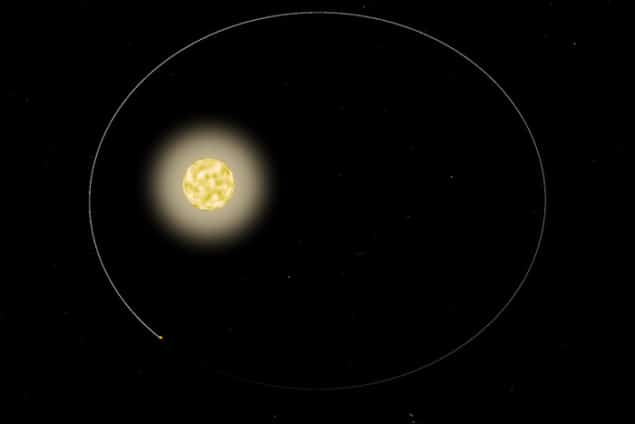Flash Physics is our daily pick of the latest need-to-know developments from the global physics community selected by Physics World‘s team of editors and reporters

Massive planet sets star pulsating
A distant star pulses each time its planet hurtles close by. 400 light-years away, the star HAT-P-2 is orbited by a massive gas giant. The planet, called HAT-P-2b, is eight times the mass of Jupiter and has a highly eccentric orbit, meaning that it passes close by the star and then hurtles far out before returning to loop back around. Using 350 hours of observations taken by NASA’s Spitzer Space Telescope, a team of scientists was studying the temperature changes in the planet, when the researchers noticed unexpected, tiny vibrations in the star’s brightness. They found that each time the planet came close to the star, the star’s light pulsed. Indeed, the oscillations correspond to the harmonics of HAT-P-2b’s orbital frequency. After ensuring the vibrations were not caused by the telescope, Julien de Wit from the Massachusetts Institute of Technology (MIT) in the US and colleagues suggest the planet may actually be large enough to periodically distort the star during its eccentric orbit. This goes against previous theoretical models and predictions regarding a planet’s relationship with the star it orbits. How the planet might be affecting the star remains unknown, however. “It’s a mystery, but it’s great,” says de Wit, “because it demonstrates our understanding of how a planet affects its star is not complete.” The study is presented in The Astrophysical Journal Letters.
United Arab Emirates sets out Mars vision
The United Arab Emirates (UAE) has announced an ambitious plan to create a human settlement on Mars within the next 100 years. The “Mars 2117” project was unveiled by Sheikh Mohammed bin Rashid Al Maktoum, ruler of Dubai and the UAE’s vice president at the 5th World Government Summit in Dubai. The first phase of the Mars 2117 project will concentrate on achieving “scientific breakthroughs” to help colonise Mars by focussing on developing faster ways to get to and from the red planet as well as how to sustain life. Mars 2117 will initially begin with a UAE-based scientific team before being extended to include international scientists. “The new project is a seed that we plant today, and we expect future generations to reap the benefits, driven by its passion to learn to unveil a new knowledge,” says Sheikh Mohammed. “The landing of people on other planets has been a long-time dream for humans. Our aim is that the UAE will spearhead international efforts to make this dream a reality.” The country has already invested around £4bn in its space agency, which was created in 2014, and the UAE is also working to send a probe to Mars in 2021, dubbed Mars Hope.
Francis Alexander new deputy director of BNL’s Computational Science Initiative

Physicist Francis Alexander has been named deputy director of the Computational Science Initiative at the US Department of Energy’s (DOE’s) Brookhaven National Laboratory. Alexander was previously at the DOE’s Los Alamos National Laboratory for more than 20 years where he held a number of leadership positions including leader of the Computer, Computational, and Statistical Sciences (CCS) Division’s Information Sciences Group and leader of the Information Science and Technology Institute. “I was drawn to Brookhaven by the exciting opportunity to strengthen the ties between computational science and the significant experimental facilities – the Relativistic Heavy Ion Collider, the National Synchrotron Light Source II, and the Center for Functional Nanomaterials [all DOE Office of Science User Facilities],” says Alexander. “The challenge of getting the most out of high-throughput and data-rich science experiments is extremely exciting to me.” Alexander will work with CSI director Kerstin Kleese van Dam to expand the department’s research portfolio and promote data-driven discovery. Alexander will also act as BNL’s primary liaison to national security agencies, as well as develop partnerships with other national laboratories and research institutions.
- You can find all our daily Flash Physics posts in the website’s news section, as well as on Twitter and Facebook using #FlashPhysics.



